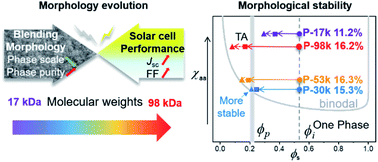Morphology evolution with polymer chain propagation and its impacts on device performance and stability of non-fullerene solar cells†
Abstract
Active layer morphology is a key factor that dictates the device performance and stability of polymer solar cells (PSCs). Herein, we investigate the morphology evolution of the active layer and the impacts on device performance and stability upon varying the molecular weights of polymer donor (PBDB-T4Cl5S) from 17 to 98 kg mol−1. When blended with a leading non-fullerene acceptor (Y6), both the short-circuit current density and fill factor of the PSCs rise gradually with increasing the polymer molecular weights. Detailed morphology analysis showed that the reduced phase separation scale and improved phase purity accounted for these enhancements. Interestingly, the best device stability was achieved by the polymer with a medium molecular weight of 30 kg mol−1, which is most likely caused by the nearly-optimal miscibility between the polymer donor and Y6. These results demonstrate that the optimization of molecular weights of polymer donors is crucial to achieve high-efficiency and high-stability simultaneously for non-fullerene PSCs.



 Please wait while we load your content...
Please wait while we load your content...